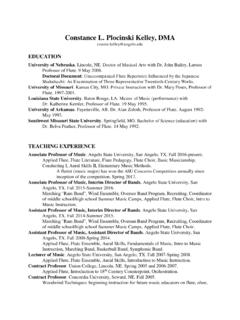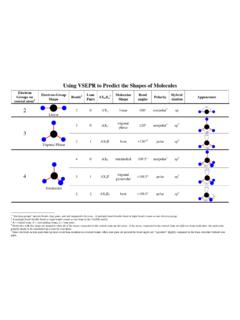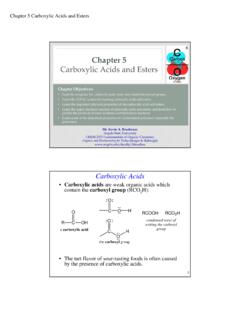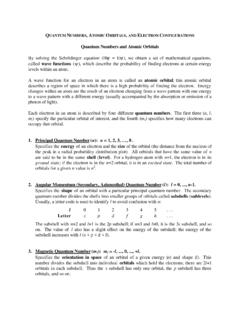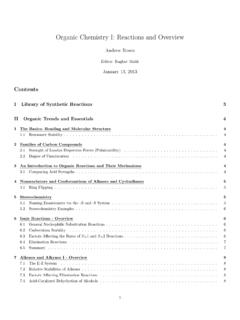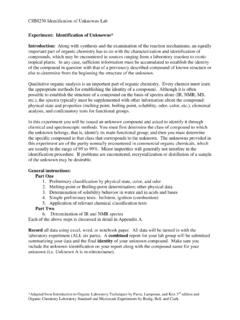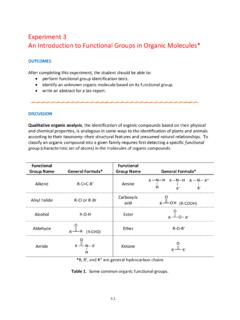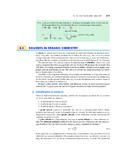Transcription of Chapter 3 Alcohols, Phenols, and Ethers
1 Chapter 3 alcohols , Phenols, and Ethers Chapter 3. alcohols , Phenols, and Ethers Chapter Objectives: Learn to recognize the alcohol, phenol , and ether functional groups. Learn the IUPAC system for naming alcohols , phenols, and Ethers . Learn the important physical properties of the alcohols , phenols, and Ethers . Learn the major chemical reaction of alcohols , and learn how to predict the products of dehydration and oxidation reactions. Learn to recognize the thiol functional group. Mr. Kevin A. Boudreaux Angelo State University CHEM 2353 Fundamentals of Organic Chemistry Organic and Biochemistry for Today (Seager & Slabaugh). Introduction In this Chapter , we will start looking at organic molecules that incorporate C O bonds. Oxygen is in Group 6A of the periodic table, and in most of its compounds, contains two single bonds and two lone pairs (or one double bond and two lone pairs), and is sp3-hybridized with a bent molecular shape: O O.
2 The alcohol, phenol , and ether functional groups are found in a number of important naturally occurring molecules: CH3CH2OH. Ethanol OH. CH3CH2 OCH2CH3. Diethyl ether HO. Menthol Cholesterol 2. 1. Chapter 3 alcohols , Phenols, and Ethers alcohols 3. The Hydroxy ( OH) Functional Group The hydroxyl group ( OH) is found in the alcohol and phenol functional groups. (Note: that's not the same as hydroxide, OH-, which is ionic.). in alcohols , a hydroxyl group is connected to a carbon atom. in phenols, OH is connected to a benzene ring. (The parent molecule of this class is also named phenol : PhOH or C6H5OH.). When two carbon groups are connected by single bonds to an oxygen, this is classified as the ether functional group. R OH OH R O R'. an alcohol an ether a phenol 4. 2. Chapter 3 alcohols , Phenols, and Ethers Where Does the Word Alcohol Come From?
3 The word alcohol comes from the Arabic term al kohl meaning the fine powder. Originally, this referred to an antimony sulfide (Sb2S3)compound used for eye shadow, which was ground up to form a fine powder, but then later came to refer to any finely divided powder. In the Middle Ages, this term came to mean the essence of anything. When the Europeans took up alchemy in the Middle Ages, they referred to vapors from evaporating or boiling compounds as spirits, since they did not believe them to be material in the same sense that solids and liquids were. Alchemists began referring to spirits of wine, and since an alcohol when it boils away seems to powder away to nothing, they also began to refer to alcohol of wine and then simply alcohol . 5. Some Common alcohols CH3OH CH3CH2OH. methanol ethanol methyl alcohol ethyl alcohol (wood alcohol) (grain alcohol).
4 ("methy" = wine, "hule" = wood) The acohol of alcoholic beverages; the Found in wood smoke; contributes to the fermentation of honey, grain, or fruit juices to bouqet of new wine; metabolized in the body yield beers and wines was probably the first to formaldehyde and formic acid, and can chemical reaction to be discovered; metabolized cause blindness or death (> 50 mL) in the body to produce acetaldehyde CH3CH2CH2OH OH. 1-propanol n-propyl alcohol CH3 CHCH3. 2-propanol isopropyl alcohol Rubbing alcohol is 70%. isopropyl alcohol and 30% water 6. 3. Chapter 3 alcohols , Phenols, and Ethers Nomenclature of alcohols and Phenols Step 1. Name the longest chain to which the hydroxyl ( OH) group is attached. The name for this chain is obtained by dropping the final -e from the name of the hydrocarbon parent name and adding the ending -ol.
5 Step 2. Number the longest chain to give the lowest possible number to the carbon bearing the hydroxyl group. Step 3. Locate the position of the hydroxyl group by the number of the C to which it is attached. Step 4. Locate and name any other substituents. Step 5. Combine the name and location for other groups, the hydroxyl group location, and the longest chain into the final name. 7. Examples: Naming alcohols and Phenols Provide acceptable IUPAC names for the following compounds: CH3 OH CH3 CH2 OH CH3 CH2 CH2 OH. OH OH. CH3 CH CH3 CH3 CH CH2 CH3. 8. 4. Chapter 3 alcohols , Phenols, and Ethers Examples: Naming alcohols and Phenols Provide acceptable IUPAC names for the following compounds: CH3 CH2 CH2 CH2 CH2 OH CH3 CH2 CH CH2 CH3. OH. CH3. CH3 CH2 CH CH CH2 OH CH3 CH2 CH2 CH CH2 CH3. CH3 CH2 OH. 9. Examples: Naming alcohols and Phenols Provide acceptable IUPAC names for the following compounds: OH.
6 OH. OH. CH2 CHCH3. 10. 5. Chapter 3 alcohols , Phenols, and Ethers Examples: Naming alcohols and Phenols Draw and name all of the possible isomers of butanol (C4H10O). 11. Nomenclature of alcohols and Phenols If there is more than one OH group, a counting prefix (di-, tri-, tetra-, etc.) is placed immediately in front of the suffix -ol (diol, triol, tetraol, etc.). Usually, the final e of the parent hydrocarbon is not dropped ( , 1,2-propanediol). The position of each alcohol group is indicated by carbon number, separated by commas ( , 1,3- butanediol). For cyclic alcohols , the carbon bearing the OH is numbered as 1.. Phenols are named after the parent compound phenol ; the C bearing the OH is numbered as 1.. 12. 6. Chapter 3 alcohols , Phenols, and Ethers Examples: Naming alcohols and Phenols Provide acceptable IUPAC names for the following compounds: OH.
7 HO CH2 CH2 OH HO CH CH2 CH CH CH3. CH3 CH3. CH2 CH CH2 CH3 OH. OH OH OH CH CH2 CH. OH CH3. 13. Examples: Naming alcohols and Phenols Provide acceptable IUPAC names for the following compounds: OH. CH3 OH. OH OH. Cl CH2CH2CH3 14. 7. Chapter 3 alcohols , Phenols, and Ethers Examples: Nomenclature of alcohols Draw structural formulas for the following molecules: 3-methyl-2-pentanol 2,4,4,5-tetramethyl-2-heptanol 1-ethyl-1-hexanol (what's wrong with this name?). 15. Examples: Nomenclature of alcohols Draw structural formulas for the following molecules: 3-ethylcyclopentanol 3-ethylphenol 3-methyl-2,4-pentanediol 16. 8. Chapter 3 alcohols , Phenols, and Ethers Classification of alcohols alcohols are classified as primary (1 ), secondary (2 ), or tertiary (3 ) according to how many carbon groups are attached to the carbon bearing the OH.
8 Group: H H R''. R C OH R C OH R C OH. H R' R'. Primary Secondary Tertiary 1 2 3 . The number of hydrogens on the carbon bearing the OH group does affect some chemical properties. 17. Physical Properties of alcohols 18. 9. Chapter 3 alcohols , Phenols, and Ethers Hydrogen Bonding The oxygen-hydrogen bond is an especially polar bond because oxygen is much more electronegative than hydrogen is. H. H. O H. - O H. + O + H O.. H H H. O. H O H. H. H. The O H bond is therefore a polar bond, and any molecule which contains an O H bond (like an alcohol) is a polar molecule. 19. Physical Properties of alcohols The general rule in solubility is like dissolves like.. Since the OH group makes alcohols polar, they will mix with polar solvents like water as long as the carbon chain is fairly short. The longer the carbon chain, the less soluble the alcohol is.
9 Water solubility Soluble Insoluble Short chain butanol pentanol Long chain alcohols alcohols methanol hexanol ethanol heptanol isopropanol etc. 20. 10. Chapter 3 alcohols , Phenols, and Ethers Hydrogen Bonding of alcohols alcohols hydrogen-bond to water: R. H. O H. O R. H O. O H. R O H. H. H. alcohols also hydrogen-bond to each other: R. H. O H. O R. H O. O R. R O H. H. R 21. Boiling Points of alcohols Because alcohols hydrogen bond to each other, they have higher boiling points than alkanes of the same molecular weight. The boiling point of alcohols increases as the molecules become larger. Name Structure Molecular Boiling Weight Point propane CH3CH2CH3 g/mol C. dimethyl ether CH3 OCH3 g/mol -24 C. ethanol CH3CH2OH g/mol C. 22. 11. Chapter 3 alcohols , Phenols, and Ethers Examples: Physical Properties of alcohols Arrange the following substances in order of increasing boiling point and increasing solubility in water: 2-butanol 2-propanol 2-methylpropane 2-pentanol 23.
10 24. 12. Chapter 3 alcohols , Phenols, and Ethers Reactions of alcohols 25. Dehydration of alcohols to Produce Alkenes Heating alcohols in concentrated sulfuric acid (H2SO4) at 180 C removes the OH group and a H. from an adjacent carbon to produce an alkene, with water as a by-product. Since water is removed . from the alcohol, this reaction is known as a dehydration reaction (or an elimination reaction): R R R R. H2SO4. R C C R C C + H2O. 180 C. H OH R R. H2SO4. CH3 CH CH3 CH3 CH CH2 + H2O. 180 C. OH 26. 13. Chapter 3 alcohols , Phenols, and Ethers Dehydration of alcohols to Produce Alkenes If there is more than one possible product of a dehydration reaction, the major product can be predicted from Zaitsev's Rule: Zaitsev's Rule when an alkene is produced in an elimination reaction, the major product is the one with the more highly substituted double bond.



